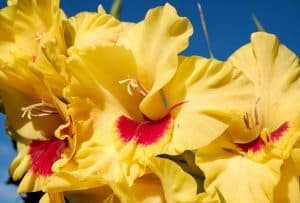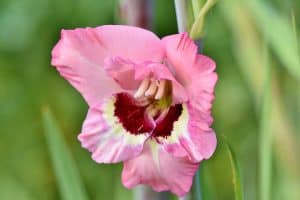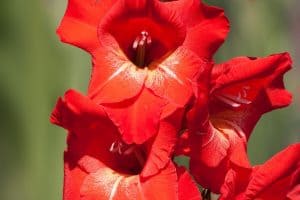Flower Glossary is reader-supported. When you buy through links on our site, we may earn an affiliate commission.
When new gardeners think of common flowers to put in their gardens thoughts initially turn to daisies, rhododendrons, roses, and tulips. Rarely do they think of the gorgeous gladiolus flower. Seasoned gardeners, on the other hand, know the color and beauty these tall perennials can bring to your garden.
Table of Contents
What is a Gladiolus Flower?

When new gardeners think of common flowers to put in their gardens thoughts initially turn to daisies, rhododendrons, roses, and tulips. Rarely do they think of the gorgeous gladiolus flower. Seasoned gardeners, on the other hand, know the color and beauty these tall perennials can bring to your garden.
Gladiolus flowers, commonly known as “glads”, are known for their tall spikes of flowers and brightly colored blooms—great for displaying in vases. They can reach about 5 feet in height, and have varying sizes of blooms from 3 to 5 inches in diameter.
Just as there is variety in their size, there is even more variety in their color. These eye-catching flowers can bloom in many colors including everything from cream and yellow to hot pink and green.
The thing about gladiolus is that they grow differently depending on which zone they’re in. With that in mind, here are some tips and tricks for planting, growing, and caring for these popular plants.
Upgrade your gardening gloves before planting season hits!
How to Plant Gladiolus Flowers

Like every new plant you add to the garden, you want to ensure you have the right growing conditions. Most gladiolus flowers grow in the summer and enjoy full sun throughout the day. Depending on the variety, they’ll root, grow, and fully bloom between 60 and 90 days after planting the bulbs. Below we’ve compiled a more detailed list of conditions to look for when planting your glads.
Soil
These flowers like well-drained soil. Using a garden fork or tiller can help to loosen the soil. You can also use manure or a layer of compost to help make the soil more fertile. If your soil is too clay-like, which is common in areas of the Midwest, then raised beds are best since these plants can’t thrive in dense soil.
Light
As mentioned, gladiolus enjoy an abundance of light. However, some varieties will thrive in partial shade. For most though, the colors won’t be as vivid if the flowers don’t have enough sunlight.
When to Plant
The best time to plant these flowers is 2 weeks before the last expected day of frost, right at the beginning of spring. It may be hard to determine this, but it’s typically safe to start planting around the beginning of May. The soil must be at least 55 degrees Fahrenheit. Plant glads every two weeks until the beginning of July to lengthen your blooming season.
Be sure to update your gardening tools this year!
Tips for Planting Gladiolus
Like many other flowers, planting near the end of the frost season is ideal. This typically means at the beginning of May. Below is our detailed list of planting tips to keep in mind:
- Plant your flowers in groups of 7 or more, if they’re planted with borders or in beds of annuals.
- Plant them in rows if you’re growing them as cutting flowers.
- Space your plants 6-8 inches apart.
- Plant the corms in holes as deep as 4 inches with the pointed end up. Cover with soil and press firmly.
- Plant corms that are 1 and a half inches in diameter to get large-sized blooms.
- Don’t plant them too close to other plants and keep weeds at bay. These flowers will compete for root space and water and more aggressive flowers can easily overtake them.
Care Tips for Gladiolus Flowers
Now that we’ve covered the planting basics for these flowers, let’s get into the finer details. It’s always vital that you check the requirements for planting, growing, and care for the variety of plants you have. This tip is important because different varieties likely have different planting requirements. Here are a few care tips for your gladiolus flowers:
- From zone 7 and colder, glads need to be dug up and replanted the next spring. Dig them up at the start of fall. Make sure to store them in a dark room that’s well-ventilated and kept at a temperature between 32-50 degrees Fahrenheit.
- Taller varieties of these flowers need to be staked for more support. Placing them against a fence or building is often wise, as long as they receive enough sunlight throughout their growing and blooming season.
- They do not need trimming or pruning, though they make great cut flowers for bouquets and vases.
- These colorful flowers need at least an inch of water per week. Increase this amount in times of drought or if the flowers are in raised beds.
- After the flowers fade you can deadhead the stalks. This will prevent them from self-sowing.
- You can add a layer of mulch, 2-3 inches thick, to keep the soil well-preserved.
- Buy corms that are not crumbly or soft to avoid pests and diseases.
- Don’t add fertilizer until you see first growths.
Common Gladiolus Diseases & Solutions

Even though glads can typically tolerate the harsh sunshine, there are some environmental impacts that could stunt their growth. But don’t be deterred, keeping these flowers free of pests is simple. Common pests attracted to these plants include:
Aster yellows
A virus-like condition that stunts plant growth and deforms petals. You can solve this by removing infected plants, controlling leafhoppers, and removing weeds in the area.
Bacterial leaf spots
Small translucent spots that slowly enlarge. If this occurs, as it does in cooler temps, remove infected plants, rotate crops with other plants in a different family, and avoid overhead watering.
Botrytis
A grey mold that infects the whole plant. This is another disease that mostly impacts plants in cooler climates. You can fix it by removing affected parts of the plant, avoid night watering, water only the soil, and ensure good air circulation.
Virus
Dark green mottling on the leaves. To solve, destroy the plant entirely, as well as plants on either side of the infected plant. Be careful not to touch any other surrounding plants, as it may cause virus spread.
Add beauty and color to your garden this year with an array of vibrant flowers. If you’re looking for tips and easy-to-read guides to help you through planting season and beyond, you’re in the right place. Flower Glossary is here to help by providing lots of information for planting, growing, and caring for flowers of all varieties.
Learn more about your favorite flowers at Flower Glossary.
